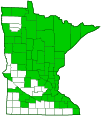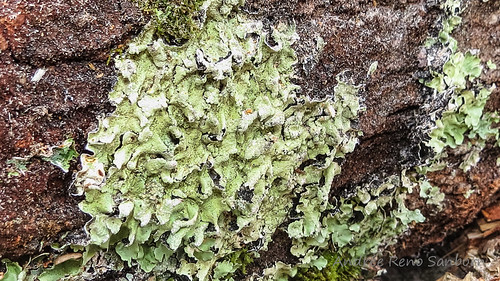Common Greenshield Lichen
(Flavoparmelia caperata)
Conservation • Description • Ecology • Distribution • Taxonomy
Conservation Status |
|
|||||||
| IUCN Red List | not listed |
|||||||
| NatureServe | NNR - Unranked |
|||||||
| Minnesota | not listed |
|||||||
Description |
||
Common Greenshield Lichen grows on bark of broadleaved trees and sometimes also on rock. The vegetative body (thallus) is 2″ to 8″ in diameter, leaf-like (foliose), and divided into lobes. It is attached to the substrate (usually bark) at occasional points by tufted or fibrous, anchoring structures (rhizines). The rhizines are black and unbranched. They are dense toward the center, sparse and short toward the margins. The lobes are irregular, rounded, flat, and ⅛″ to 5 ⁄16″ in diameter. The upperside is pale yellowish-green and is not spotted. It is smooth at first, often becoming rough, wrinkled, and folded with age. The underside is black except at the edges, where it is pale brown. It rarely produces spore-producing structures (apothecia). |
||
Similar Species |
||
Hammered Shield Lichen (Parmelia sulcata) is gray, never green. The lobes have a network of raised ridges giving at a hammered appearance. Rock Greenshield Lichen (Flavoparmelia baltimorensis) has globe-shaped, pustular outgrowths on the upper surface. It grows only on rocks. Speckled Greenshield Lichen (Flavoparmelia flavientor) has white pores on the upper surface. |
||
Ecology |
||
Substrate |
||
Trees |
||
Growth Form |
||
Foliose |
||
Habitat |
||
Bark of broadleaved trees, fence posts, and sometimes also on rock. Also found in human populated areas. |
||
Hosts |
||
|
||
Distribution |
||||
|
Sources |
|||
| 5/29/2022 | ||||
Occurrence |
||||
Widespread and extremely common |
||||
Taxonomy |
|||
| Kingdom | Fungi (Fungi) | ||
| Subkingdom | Dikarya | ||
| Phylum | Ascomycota (Sac Fungi) | ||
| Subphylum | Pezizomycotina (Sac Fungi and Lichens) | ||
| Class | Lecanoromycetes (Common Lichens) | ||
| Subclass | Lecanoromycetidae (Shield Lichens, Sunburst Lichens, Rosette Lichens, and Allies) | ||
Order |
Lecanorales (shield lichens, rim lichens, and allies) | ||
Suborder |
Lecanorineae | ||
Family |
Parmeliaceae (shield lichens and allies) | ||
| Subfamily | Parmelioideae (typical shield lichens) | ||
Genus |
Flavoparmelia (greenshield lichens) | ||
| Mycobiont | Flavoparmelia caperata | ||
| Photobiont | |||
Synonyms |
|||
Parmelia caperata Parmelia cylisphora Parmelia flavicans Parmelia herreana Parmelia negativa Pseudoparmelia caperata |
|||
Common Names |
|||
Common Green Shield Lichen Common Greenshield Lichen Flavoparmelia Lichen |
|||
Glossary
Apothecia
An open, disk-shaped or cup-shaped, reproductive structure, with spore sacs on the upper surface, that produces spores for the fungal partner of a lichen.
Foliose
Adjective: Leaf-like growth form; referring to lichens with leaf-like growths divided into lobes.
Noun: The leaf-like, vegetative body of a lichen (thallus) that has thin, flat lobes which are free from the substrate.
Rhizine
A root-like structure of a lichen that attaches the lower layer to the substrate.
Thallus
The vegetative body of a lichen composed of both the alga and the fungus.
Pollution Tolerant
Unlike most lichens, Greenshield lichens (Flavoparmelia spp.) are relatively tolerant of air pollution. They are among the first noticeable lichens to return to areas that have been rid of lichens due to pollution.
Visitor Photos |
|||||
Share your photo of this fungus. |
|||||
| This button not working for you? Simply email us at info@MinnesotaSeasons.com. Attach one or more photos and, if you like, a caption. |
|||||
Luciearl |
|||||
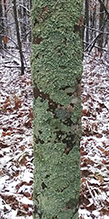 |
|||||
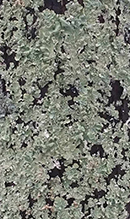 |
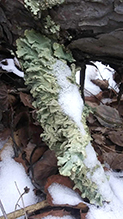 |
||||
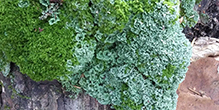 |
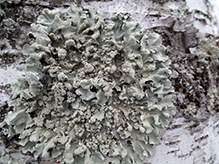 |
||||
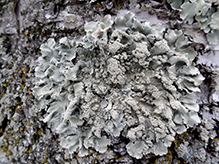 |
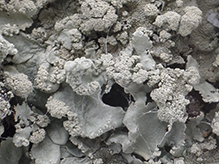 |
||||
Alfredo Colon |
|||||
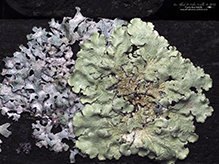 |
|||||
Luciearl |
|||||
 |
 |
||||
 |
|||||
MinnesotaSeasons.com Photos |
|||||
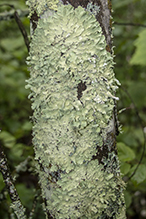 |
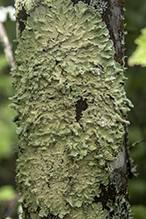 |
||||
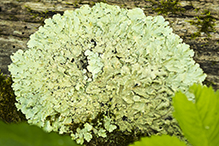 |
|||||

Visitor Videos |
|||
Share your video of this fungus. |
|||
| This button not working for you? Simply email us at info@MinnesotaSeasons.com. Attach a video, a YouTube link, or a cloud storage link. |
|||
Other Videos |
|||
| Flavoparmelia caperata lichen - Líquen verde - Líquens (Parmeliaceae) DiegoDCvids |
|||
About
Published on May 27, 2015 Flavoparmelia caperata - common greenshield lichen - Líquen verde - Líquens de árvore - Líquen na árvore (Fungi - Ascomycota - Lecanoromycetes - Lecanorales - Parmeliaceae) Micobionte, Ficobionte, Biodiversidade, Biodiversity, Nature videos, Vídeos de Natureza, Santo Amaro da Imperatriz, Florianópolis, Santa Catarina, Brasil Os líquenes são organismos muito particulares, que resultam de uma associação simbiótica estável entre um fungo e uma alga, ou uma cianobactéria. Esta associação permite que os líquenes se desenvolvam em habitats onde nenhum dos seus constituintes conseguiria sobreviver sozinho. A simbiose confere aos líquenes características muito próprias, entre as quais uma elevada sensibilidade a poluentes ambientais que os torna excelentes indicadores da qualidade do ar e do habitat. De um modo geral, um elevado número de espécies é sempre indicador de boa qualidade atmosférica original videos filmings, 3D modelings, arts animations created and directed by Diego da Cruz Pereira (DiegoDCvids) Google translation: Lichens are very particular organisms, resulting in a stable symbiotic association between a fungus and an alga or a cyanobacterium. This association allows lichens are developed in habitats where none of his constituents could survive alone. The symbiosis gives very specific features lichens, including a high sensitivity to environmental pollutants which makes them excellent indicators of air quality and habitat. In general, a large number of species is always good indicator of air quality original filmings videos, 3D modelings, animations arts created and directed by Diego da Cruz Pereira (DiegoDCvids) |
|||


Last Updated:
